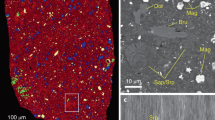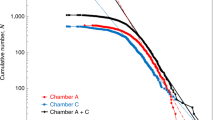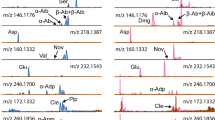Abstract
Understanding the nature and origin of the asteroid population in Earth’s vicinity (near-Earth asteroids, and its subset of potentially hazardous asteroids) is a matter of both scientific interest and practical importance1. It is generally expected that the compositions of the asteroids that are most likely to hit Earth should reflect those of the most common meteorites. Here we report that most near-Earth asteroids (including the potentially hazardous subset) have spectral properties quantitatively similar to the class of meteorites known as LL chondrites. The prominent Flora family in the inner part of the asteroid belt shares the same spectral properties, suggesting that it is a dominant source of near-Earth asteroids. The observed similarity of near-Earth asteroids to LL chondrites is, however, surprising, as this meteorite class is relatively rare (∼8 per cent of all meteorite falls). One possible explanation is the role of a size-dependent process, such as the Yarkovsky effect, in transporting material from the main belt.
This is a preview of subscription content, access via your institution
Access options
Subscribe to this journal
Receive 51 print issues and online access
$199.00 per year
only $3.90 per issue
Buy this article
- Purchase on Springer Link
- Instant access to full article PDF
Prices may be subject to local taxes which are calculated during checkout


Similar content being viewed by others
References
Gehrels, T., Matthews, M. S. & Schumann, A. M. Hazards Due to Comets and Asteroids (Univ. Arizona Press, 1994)
Binzel, R. P. et al. Observed spectral properties of near-Earth objects: Results for population distribution, source regions, and space weathering processes. Icarus 170, 259–294 (2004)
Stuart, J. S. & Binzel, R. P. Bias-corrected population, size distribution, and impact hazard for the near-Earth objects. Icarus 170, 295–311 (2004)
Rayner, J. T. et al. A medium-resolution 0.8–5.5 micron spectrograph and imager for the NASA Infrared Telescope Facility. Publ. Astron. Soc. Pacif. 115, 362–382 (2003)
Shkuratov, Y., Starukhina, L., Hoffmann, H. & Arnold, G. A model of spectral albedo of particulate surfaces: Implications for optical properties of the Moon. Icarus 137, 235–246 (1999)
Lucey, P. G. Model near-infrared optical constants of olivine and pyroxene as a function of iron content. J. Geophys. Res. 103, 1703–1714 (1998)
Hutchison, R. Meteorites: A Petrologic, Chemical and Isotopic Synthesis (Cambridge Univ. Press, 2004)
Clark, B. E., Hapke, B., Pieters, C. & Britt, D. in Asteroids III (eds Bottke, W. F., Cellino, A., Paolicchi, P. & Binzel, R. P.) 585–599 (Univ. Arizona Press, 2002)
Brunetto, R. et al. Modeling asteroid surfaces from observations and irradiation experiments: The case of 832 Karin. Icarus 184, 327–337 (2006)
Bottke, W. F., Vokrouhlikcy, D., Rubincam, D. P. & Broz, M. in Asteroids III (eds Bottke, W. F., Cellino, A., Paolicchi, P. & Binzel, R. P.) 395–408 (Univ. Arizona Press, 2002)
Nesvorný, D., Morbidelli, A., Vokrouhlický, D., Bottke, W. F. & Brož, M. The Flora family: A case of the dynamically dispersed collisional swarm? Icarus 157, 155–172 (2002)
Chapman, C. R. S-type asteroids, ordinary chondrites, and space weathering: The evidence from Galileo's fly-bys of Gaspra and Ida. Meteorit. Planet. Sci. 31, 699–725 (1996)
Gaffey, M. J. Rotational spectral variations of asteroid 8 Flora: Implications for the nature of S-type asteroids and for the parent bodies of ordinary chondrite meteorites. Icarus 60, 83–114 (1984)
Nesvorný, D., Vokrouhlický, D., Bottke, W. F., Gladman, B. & Häggström, T. Express delivery of fossil meteorites from the inner asteroid belt to Sweden. Icarus 188, 400–413 (2007)
Maier, W. D. et al. Discovery of a 25-cm asteroid clast in the giant Morokweng impact crater, South Africa. Nature 441, 203–206 (2006)
Tagle, R. & Hecht, L. Geochemical identification of projectiles in impact rocks. Meteorit. Planet. Sci. 41, 1721–1735 (2006)
Rubincam, D. P. Asteroid orbit evolution due to thermal drag. J. Geophys. Res. 100, 1585–1594 (1995)
Bottke, W. F., Rubincam, D. P. & Burns, J. A. Dynamical evolution of main belt meteoroids: Numerical simulations incorporating planetary perturbations and Yarkovsky thermal forces. Science 145, 301–331 (2000)
McFadden, L. A., Gaffey, M. J. & McCord, T. B. Near-earth asteroids — Possible sources from reflectance spectroscopy. Science 229, 160–163 (1985)
Bus, S. J. Compositional Structure in the Asteroid Belt: Results of a Spectroscopic Survey. Thesis, Massachusetts Inst. Technol. (1999)
Pieters, C. M. et al. Space weathering on airless bodies: Resolving a mystery with lunar samples. Meteorit. Planet. Sci. 35, 1101–1107 (2000)
Chapman, C. R. Space weathering of asteroid surfaces. Annu. Rev. Earth Planet. Sci. 32, 539–567 (2004)
Binzel, R. P., Bus, S. J., Burbine, T. H. & Sunshine, J. M. Spectral properties of near-Earth asteroids: Evidence for sources of ordinary chondrite meteorites. Science 273, 946–948 (1996)
Sunshine, J. M., Pieters, C. M. & Pratt, S. F. Deconvolution of mineral absorption bands — An improved approach. J. Geophys. Res. 95, 6955–6966 (1990)
Gaffey, M. J. et al. Mineralogical variations within the S-type asteroid class. Icarus 106, 573–602 (1993)
Acknowledgements
We acknowledge S. M. Slivan (Wellesley College) for data processing software development. Most data were acquired by the authors operating as Visiting Astronomers at the IRTF, which is operated by the University of Hawaii under cooperative agreement NNX08AE38A with NASA’s Science Mission Directorate, Planetary Astronomy Program. This Letter is based on work supported by the NSF (grant 0506716) and NASA (grant NAG5-12355). Any opinions, findings, and conclusions or recommendations expressed here are those of the authors and do not necessarily reflect the views of the NSF or NASA.
Author Contributions P.V. performed the quantitative mineral analysis that solidified the results of this Letter, and led the formulation of possible explanations. C.A.T. provided the quantitative analysis of spectral properties. S.J.B. provided the comparison to the Flora region. R.P.B. and A.T.T. served as principal investigators for a joint observing programme to acquire the near-infrared data. Most data were acquired by R.P.B, S.J.B. and C.A.T., while F.E.D. performed most of the processing. Processing routines were developed by S.J.B., A.S.R. and R.P.B. P.V. and R.P.B. worked jointly to write the Letter. All authors discussed the results and commented on the manuscript.
Author information
Authors and Affiliations
Corresponding author
Supplementary information
Supplementary Information
The file contains Supplementary Notes, Supplementary Discussion, Supplementary Figure 1 and Legend, additional references. (PDF 188 kb)
PowerPoint slides
Rights and permissions
About this article
Cite this article
Vernazza, P., Binzel, R., Thomas, C. et al. Compositional differences between meteorites and near-Earth asteroids. Nature 454, 858–860 (2008). https://doi.org/10.1038/nature07154
Received:
Accepted:
Issue Date:
DOI: https://doi.org/10.1038/nature07154
This article is cited by
-
Impact-driven disproportionation origin of nanophase iron particles in Chang’e-5 lunar soil sample
Nature Astronomy (2022)
-
A micrometeorite from a stony asteroid identified in Luna 16 soil
Nature Astronomy (2022)
-
First light of SOVAG, a spectrograph for visible and near-infrared observation of asteroids
Experimental Astronomy (2021)
-
Exploring the Bimodal Solar System via Sample Return from the Main Asteroid Belt: The Case for Revisiting Ceres
Space Science Reviews (2020)
-
Thermal and impact histories of 25143 Itokawa recorded in Hayabusa particles
Scientific Reports (2018)
Comments
By submitting a comment you agree to abide by our Terms and Community Guidelines. If you find something abusive or that does not comply with our terms or guidelines please flag it as inappropriate.



